BestReviews is reader-supported and may earn an affiliate commission. Details
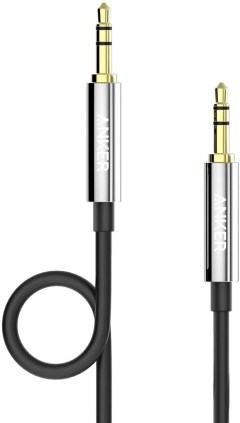
A trusted brand delivering one of the best AUX cables on the market.
A trusted brand delivering one of the best AUX cables on the market.
This 4-foot-long cable's universal fit means it will work for any device that takes this input, whether it is a phone or a car stereo. The cable's high quality makes it sturdy and durable enough to avoid any tears, even with excessive bending. The overall design itself looks great and the gold input tips help the cable respond quicker.
Usually sold in only a single pack.
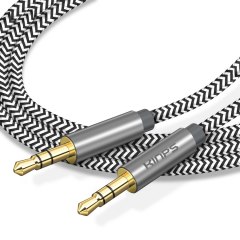
With a durable nylon casing and sound quality comparable to some higher-end models, this cord offers durability and sound clarity to users on a budget.
With a durable nylon casing and sound quality comparable to some higher-end models, this cord offers durability and sound clarity to users on a budget.
Flat nylon casing is more resistant to kinks than most rubber-coated cables, meaning this 3.5-millimeter cord can stand up to a lot of use. Podcasts and music both come through surprisingly clear, with quality users might expect from more expensive cables. Gold-plated connectors resist wear, and the standard 10-foot length meets the needs of most users.
This model tends to make crackling and static sounds when not actively in use.
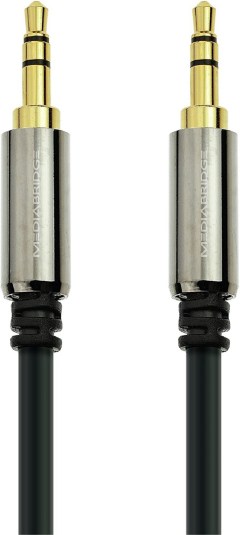
With a sound quality that compares favorably to most aux cables, this model stands out for its unique cord length and compatibility with multiple devices.
With a sound quality that compares favorably to most aux cables, this model stands out for its unique cord length and compatibility with multiple devices.
Mediabridge's 12-foot cable eliminates tangles and messes, with just enough extra cable for the needs of most users. We also love the step-down design, which allows extra space between the grip and connector so it fits snugly in virtually every device, even when using a case. With very little noise interference, the 3.5-millimeter cable provides good, quality audio.
Some users report the cord casing may form a split near the connectors with frequent use.
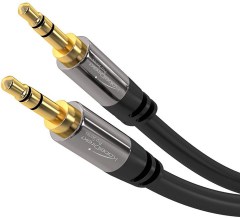
This cord stands out for its versatility and durability when used in various locations and with different devices.
This cord stands out for its versatility and durability when used in various locations and with different devices.
Portability is an important feature of a short cord, and the hard rubber casing is designed to withstand lots of handling. Can be moved from car to home and back without sacrificing sound quality or causing too much wear on the cable. Gold-plated connectors are durable as well and provide high-quality sound through the double-shielded connection. Fits snugly into all standard auxiliary cable ports.
Casing is thicker than some other models, so this may not be a good option for users who need a cable that can be threaded into smaller spots.
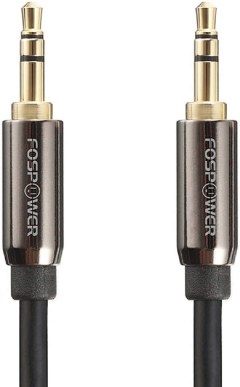
At 25 feet, this cable offers quality sound for a household that needs to connect 2 devices across a room, and it's tough enough to stand up to commercial use.
At 25 feet, this cable offers quality sound for a household that needs to connect 2 devices across a room, and it's tough enough to stand up to commercial use.
While FosPower makes cables in smaller sizes, it's the versatility of their professional-grade, 25-foot cable that earns it a spot on the list. This is long enough to stretch across the average household room, while the length also makes it useful for commercial audio setups. Tin-plated copper core and thick insulated coating are tough enough to stand up to a job environment. The 24k gold connectors offer commercial-quality sound.
This long cord will tangle if given too much slack during use and is impractical for use in cars or with handheld devices.

We recommend these products based on an intensive research process that's designed to cut through the noise and find the top products in this space. Guided by experts, we spend hours looking into the factors that matter, to bring you these selections.

If you’re a big fan of music, you probably already know this, but for those just starting, one bit of truth stands out: for the best sound, you’re going to need quality aux (auxiliary) cables. These simple and inexpensive 3.5 mm stereo plug-tipped cables are indispensable when using smartphones, MP3 players, laptops, TVs, and numerous other devices to listen to music in your home, car, and other locations.
Despite their simple appearance, there is quite a bit going on with your typical aux cable, and we advise know more about these before you purchase one, from durability and sound quality to specific elements such as connectors, grips, and cable casings.

Durability is a key issue with aux cables, particularly if you often take your cable on the road. The more durable the cable, the longer it will last and the better the sound clarity will be throughout its lifespan. Durability is such an important element that it’s measured in an aux cable’s bend lifespan, a way to determine how much flexion a cable can withstand before wear starts to become a problem. We will return to the issue of durability throughout this guide.
Another big consideration when shopping for an aux cable is an obvious one: how does the cable sound? Some of these offer higher quality, with clear sound and little noise interference. An aux cable should have the best sound quality not only when it’s being used, but also when it is idle (such as no crackling when you move the cable).

Aux cables exist in a wide array of lengths, and the length you need is largely going to be determined by its use. Hooking an MP3 player up to the aux port of your car is going to require a much shorter cable than hooking the same player into your home stereo system from across the living room.
When shopping for an aux cable, it’s a good idea to measure first to figure out what length of cable you need. Resist buying a longer cable “just in case,” because this will leave you with coils of cable to contend with until (or if) that “just in case” moment arrives. This is particularly true if you’re planning to use the cable on the move. Many sellers offer a variety of cable lengths to choose from. If one doesn’t have the length you need, move on to the next.
Connectors: The connectors at the end of the cable should be gold-plated. The majority of mid- to higher-priced aux cables offer gold-plated connectors, and for good reason. Gold plating helps to reduce wear and tear, making for more durable connectors that also resist corrosion and tarnish. They also offer better quality in the form of improved sound transmission and less interference.
Grips: The grips are next to the connectors. These are the parts you hold when you’re plugging in or unplugging the cable. While some are plastic, the best grips are some form of metal, often chrome-plated for strength. Grips also serve as caps that keep the inner components of the cable safe. If they screw on, check that the grips screw securely to the connectors and don’t loosen on their own.
Try to avoid grips that are too thick, because these can interfere with your ability to plug the cable into some devices, particularly those with thick cases. One way that some manufacturers solve this problem is by using step-down design, with a narrower area between the connector and the grip.
The cable itself is usually a wire wrapped in several layers of insulation covered by a jacket. Cables can vary considerably in thickness, which could be an issue if you’re trying to thread the cable into a tight space.
Wires: The wires are usually copper, and the higher the quality of copper used, the more durable the wire will be and the better the sound it will have. Tin-plating can help to reduce oxidation.
Insulation: Insulation can minimize signal loss and help to shield the wire from electromagnetic interference (EMI) and radio-frequency interference (RFI). It can also serve as a barrier to keep oxygen from the wire, which can lead to static electricity, yet another factor that can negatively affect the signal. Insulation can vary considerably in cables. Common insulating materials include braided copper, aluminum foil, and even foam, and you may find more than one type combined for dual shielding. You can often tell the quality of a cable simply by examining its insulation.
Jacket: Holding it all together and protecting the cable is the jacket. This casing is usually constructed from rubber or nylon. The best casing resists tangling, kinking, fraying, and splitting, and also results in a longer-lasting and more durable cable.
As mentioned above, the price range for aux cables is fairly narrow. They start at around $6 and go up to around $11. While you tend to find higher-quality cables at higher price points (as evidenced by the gold-plated connectors, greater durability, and cleaner sound), what you’re mainly paying more for is more cable. Simply put: except in rare cases, more expensive aux cables are longer. Also check any manufacturer’s warranty, which can vary from none to a limited lifetime warranty.

Q. What is the correct length of aux cable that I should be using in my car?
A. This will vary depending on your specific needs, but shorter is generally better in a situation such as this. Too long of a cable and you’re going to be swimming in coils of cable and constantly becoming entangled. A 3-foot cable should be more than enough for the majority of users and vehicles. If you think that the distance between your device and the aux input will be longer, bump the length up to 4 or 6 feet.
Q. Do longer cords have more issues with loss of sound quality than shorter cords?
A. The length of the cable should have no bearing on audio quality. The audio should sound the same at 4 feet as it does at 25 feet. As such, concentrate on buying the length of cable you need and don’t worry whether your decision will affect the sound quality. It won’t.
Q. Will these cables also charge a mobile phone or other device when you’re using it?
A. Aux cables are for audio only and won’t recharge something like a smartphone. For charging, you’ll need to use a USB cable of the proper size for your device.
Get emails you’ll love.
Learn about the products you’re wondering if you should buy and get advice on using your latest purchases.
